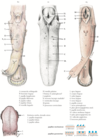C3 - Tongue, blood supply and innervation Flashcards
Structures to mention on the tongue
- Corpus linguae
-
Radix linguae (Caudal to papillae vallatae, → hyoid bone)
- Tonsilla lingualis (Bo, eq) (lymphatic follicles)
- Papilla tonsillaris (su)
- Apex linguae
- Dorsum linguae (Dorsal part of the tongue)
- Torus linguae (Ru) (Prominence of the dorsum caudal to the fossa linguae)
- Fossa linguae (bo) (Deep pit on the dorsum linguae)
- Facies ventralis linguae
- Frenulum linguae (Ventral median fold that attaches the tongue to the floor of the mouth, sus, bo: doubled)
-
Papillae linguales (Covers the dorsal surface)
- Papillae filiformes
- Papillae conicae
- Papillae fungiformes (Have tastebuds)
- Papillae lentiformes (Ru) (Mechanical)
- Papillae vallatae (Have tastebuds)
- Papillae foliatae (ø ru?) (Have tastebuds)
- Papillae marginales (car, sus) (Present in newborns)
- Sulcus medianus linguae (Median dorsal groove)
- Septum linguae
- Lyssa (ca) (It continues caudally between mm. genioglossi by a cord)
- Cartilago dorsi linguae (eq)
Musculi linguae:
- M. genioglossus
- M. hyoglossus
- M. styloglossus
-
M. lingualis proprius
- Fibrae longitudinales superficiales
- Fibrae longitudinales profundae (eq)
- Fibrae transversae
- Fibrae perpendiculares
Give the interspecies differences of the tongue
- Lyssa (car)
- Sulcus medianus (eq, car)
- Torus linguae (ru)
- Fossa linguae (bo)
- Cartilago dorsi linguae (eq)
- Papilla lentiformis (ru)
- Papilla foliatae (ø ru)
- Papilla marginalis (car, su) (newborns)
- Radix lingua
- Tonsilla lingualis (Bo, eq)
- Papilla tonsillaris (su)
- Fibrae longitudinalis profundae (eq) (intrinsic muscles of the tongue)
- Number of circum vallate papillae:
- Eq, su: 1 pair
- Ox: 8-17 pair
- Car: 2-3 pair
Where does the radix linguae attach
Hyoid bone
List the papilla of the tongue
- Mechanical:
-
Papillae filiformis
- Covers dorsum linguae
- Car, su: covers radix linguae
- Papillae conicae
- Papillae lentiformis (ru)
-
Papillae filiformis
- Gustatory:
-
Papilla fungiformis
- On dorsum linguae
- On lateral and ventral surface of the tongue
-
Papillae foliata (ø ru)
- On the borders of the tongue
-
Papillae vallata
- On dorsum linguae
- Su, eq: one pair
- Car: 2-3 papillae on each side
- Ox: 8-17 papillae
-
Papilla fungiformis
- Papilla marginalis (newborn car, su)
Give the main divisions of the tongue
- Dorsum linguae
- Apex linguae
- Corpus linguae (between apex and radix)
- Radix linguae
- Maro linguae (margin of the tongue)
- Frenulum linguae
- Ductus thyroglossus
- Septum linguae
- Aponeurosis linguae
Dorsum linguae
- Surface opposite the palate
- Torus linguae (ru)
- Fossa linguae (ru)
- Cartilage dorsi linguae (eq)
- Sulcus medianus linguae
Apex linguae
- Free rostral portion
- Tip
- Presents dorsal and ventral surface
- Ventral surface: connected to the floor of the oral cavity by frenulum linguae (median flod)
- Lyssa (car)
Radix linguae
- Caudal part of papilla vallata
- Slopes caudally towards the base of epiglottis
-
Tonsilla lingualis (eq, bo)
- Lymphoid follicles
- On the radix
-
Tonsilla lingualis (su)
- Conicale papillae
- Contains lymph nodes
- On the radix
Frenulum linguae
- Ventral median fold
- Attaches the tongue to the floor of the mouth
- Su, bo: doubled
Ductus thyroglossus
- Epithelial tube
- Evaginates from the radix
- Gives rise to gl. thyroidea
- In for. cecum
Septum linguae
Sheet of connective tissue in the median plane
Aponeurosis linguae
- Dense layer of connective tissue
- Covers the musculature
- Attachment of the muscles
Draw the tongue of:
- Bo
- Ca
- Eq

- List the muscles of the tongue
- Draw the muscles
Intrinsic muscles:
- Fibrae longitudinalis superficialis
- Fibrae longitudinalis profunda (eq)
- Fibrae transversa
- Fibrae perpendicularis
Extrinsic muscles:
- M. styloglossus
- M. hyoglossus
- M. genioglossus
Other muscles acting on the tongue
- M. geniohyoideus
- M. mylohyoideus
- M. sternohyoideus
- M. thyrohyoideus
- M. sternothyroideus
- M. occipitohyoideus

Extrinsic muscles
M. styloglossus
- Origin: Stylohyoid bone
- Insertion: Middle of tongue
- Action: Retract and elevate tongue
Extrinsic muscles
M. hyoglossus
-
Origin:
- Thyrohyoid
- Basihyoid
- Insertion: Radix linguae
- Action: Retracts and depress tongue
Extrinsic muscles
M. genioglossus
- Origin: Symphysis and adjacent surface of the body of mandibula
- Insertion: Left and right join at the median plane
-
Action:
- Caudal fibers: protrude tongue
- Rostral fibers: retract apex
Other muscles acting on the tongue
M. geniohyoideus
- Origin: Symphysis mandibularis
- Insertion: Basihyoid
- Action Draws the hyoid apparatus and larynx rostrally
Other muscles acting on the tongue
M. mylohyoideus
- Origin: Basihyoid caudally
- Insertion: Midventral raphe, om the muscle from the other side
- Action: Supports tongue
Other muscles acting on the tongue
M. sternohyoideus
-
Origin:
- Sternum
- 1st costal cartilage
- Insetion: Basihyoid
- Action: Pull the hyoid bone, radix linguae and larynx caudally
Other muscles acting on the tongue
M. thyrohyoideus
- Origin: Cartilago thyroidea
- Insertion: Thyrohyoid bone
- Action:?
Other muscles acting on the tongue
M. sternothyroideus
- Origin: 1st costal cartilage
- Insertion: Cartilago thyroidea
- Action: Draws larynx and tongue caudally
Blood supply of the tongue
-
A. lingualis
- Ca, sus: ex a. carotis externa
- Eq, ru: ex tr. linguofascialis
- Runs with stylohyoid bone, then enters into linguae: a. profunda linguae
-
A. sublingualis
- Ca, eq: a. submentalis, ex a. fascialis
- Ru, sus: ex a. lingualis
- V. lingualis from v. linguofascialis (arcus hyoideus)
-
V. sublingualis
- Ca, sus, ru: ex v. ingualis
- Eq: ex v. fascialis
Innervation of the tongue
- 5 pairs of cranial nerves:
- N. mandibularis ex n. trigemini (V)
- N. fascialis (VII)
- N. glossopharyngeus (IX)
- N. vagus (X)
- N. hypoglossus (XII) (only motor nerve of the tongue)
- The other nerves (ø n. hypoglossus) are:
- Sensory
- Tactile
- Pain
- Gustatory
- Temperature
- Sensory


